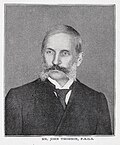File:STONE ANIMALS, MING TOMBS.jpg

Original file (7,045 × 4,440 pixels, file size: 6.04 MB, MIME type: image/jpeg)
| This is a file from the Wikimedia Commons. Information from its description page there is shown below. Commons is a freely licensed media file repository. You can help. |
Summary
| DescriptionSTONE ANIMALS, MING TOMBS.jpg |
English: John Thomson: THE tombs of the Ming Emperors of China stand about thirty miles north of Peking, and in their general design resemble those of Nanking, which I have already described. They are, however, in their dimensions still more imposing than even the tomb of Hung-woo, the first sovereign of the dynasty.
In this valley of tombs, which is backed by a crescent-shaped range of hills, having a radius of from two to three miles, the mausolea of thirteen Ming sovereigns are to be found. The first interred there was Ching-tsoo (better known as Yung-lo), the third monarch of the dynasty, and who succeeded in driving his nephew from the throne. I have chosen the illustrations for this subject from the tomb of Yung-lo partly on account of its historical interest and partly because it affords the finest example of these funereal monuments to be found in China. They are interesting besides because they show the durability of monumental and sacred architecture among the Chinese. There are in China no architectural remains which can boast of a very remote antiquity; the reason for this has never been clearly explained, some writers attributing it to political convulsions, and others to the constant use of materials less durable than stone. It seems strange therefore that they should have preserved their ancient classical books, written many of them on bamboo. In this perhaps we may see something of the practical common sense of the people. Their sages uttered imperishable truths and imparted wise councils, which have had an important influence in keeping the nation together; hence they perhaps set the less store upon useless stone edifices, which can do nothing except perpetuate an empty fame. Many of their sages and emperors esteeming no honour so great as to have their deeds handed down in living tradition through endless generations. The monument which has the greatest antiquity is the famous wall erected as a barrier against their nomadic foes. The tomb of Yung-lo is approached first through an avenue of animals, sculptured out of white lime-stone, and then through a double row of stone warriors. The latter present much the same characteristics as those erected in front of the tomb of Yung-lo's father at Nanking, twenty-four years earlier; and art does not appear to have made much progress within that period of time. All the figures wear an expression of tranquil repose, thoroughly in keeping with their duty as the guardians of the dead. As to the animals there are two pairs of each kind, two of which are kneeling and two standing upright. Thus we first meet two pairs of lions; then two pairs of unicorns; these are followed by two pairs of camels, one of which is shown in the foreground. Two pairs of elephants succeed, and beyond these are two pairs of fabulous animals called " keaon," and still further on are the mail-clad warriors. |
||||||||||||||||||||
| Date |
before 1898 date QS:P,+1898-00-00T00:00:00Z/7,P1326,+1898-00-00T00:00:00Z/9 |
||||||||||||||||||||
| Source | Beinecke Rare Book & Manuscript Library | ||||||||||||||||||||
| Author |
creator QS:P170,Q736862 |
||||||||||||||||||||
Licensing
| Public domainPublic domainfalsefalse |
|
This work is in the public domain in its country of origin and other countries and areas where the copyright term is the author's life plus 70 years or fewer. Note that a few countries have copyright terms longer than 70 years: Mexico has 100 years, Jamaica has 95 years, Colombia has 80 years, and Guatemala and Samoa have 75 years. This image may not be in the public domain in these countries, which moreover do not implement the rule of the shorter term. Honduras has a general copyright term of 75 years, but it does implement the rule of the shorter term. Copyright may extend on works created by French who died for France in World War II (more information), Russians who served in the Eastern Front of World War II (known as the Great Patriotic War in Russia) and posthumously rehabilitated victims of Soviet repressions (more information).
| |
| This file has been identified as being free of known restrictions under copyright law, including all related and neighboring rights. | |
https://creativecommons.org/publicdomain/mark/1.0/PDMCreative Commons Public Domain Mark 1.0falsefalse
File history
Click on a date/time to view the file as it appeared at that time.
| Date/Time | Thumbnail | Dimensions | User | Comment | |
|---|---|---|---|---|---|
| current | 14:05, 25 January 2014 |  | 7,045 × 4,440 (6.04 MB) | 維基小霸王 | User created page with UploadWizard |
File usage
The following 2 pages use this file:
Metadata
This file contains additional information, probably added from the digital camera or scanner used to create or digitize it.
If the file has been modified from its original state, some details may not fully reflect the modified file.
| Width | 11,256 px |
|---|---|
| Height | 8,420 px |
| Bits per component |
|
| Pixel composition | RGB |
| Orientation | Normal |
| Number of components | 3 |
| Horizontal resolution | 72 dpi |
| Vertical resolution | 72 dpi |
| Software used | Adobe Photoshop CS6 (Windows) |
| File change date and time | 15:48, 23 January 2014 |
| Exif version | 2.21 |
| Color space | Uncalibrated |
| Unique ID of original document | 4472A376E118DBAD74080D51C59798D2 |
| Date and time of digitizing | 18:49, 18 January 2014 |
| Date metadata was last modified | 23:48, 23 January 2014 |
| IIM version | 5,823 |
